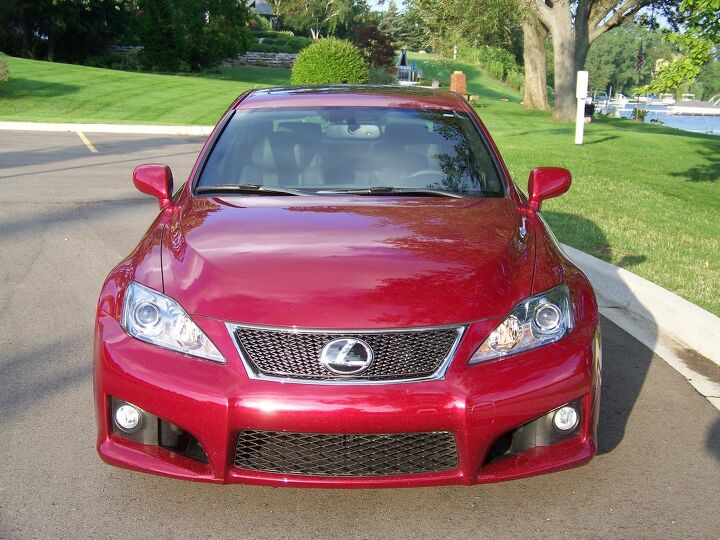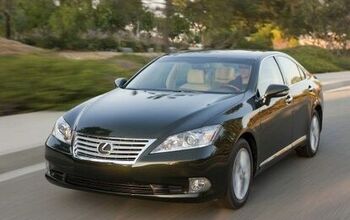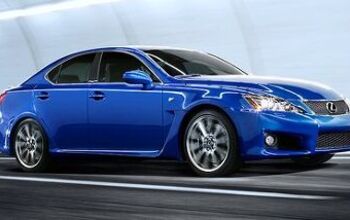Review: 2010 Lexus IS-F
Robert Farago didn’t have many kind words for the cars he reviewed. But, while noting the car’s shortcomings, he lavished quite a few on the Lexus IS-F, even implying that he’d like to own one. How did Lexus’s first attempt at an ultra-high-performance car manage to melt RF’s normally stone cold heart?
Reviewers haven’t been kind to the IS-F’s exterior styling, and RF was no exception. I certainly had a WTF moment the first time I spied the F’s fender gills and diagonally stacked faux exhaust tips. There’s no shortage of tuners without taste, but usually the factory does better. Some changes were made for 2010; why wasn’t the body kit among them?
I had a second WTF moment when the tested car first pulled into my driveway, but this time in a good way. Apparently the right shade of metallic red paint with the right dark gray forged alloy wheels (a new design for 2010) transform this car into a stunner, at least when seen in person (the photos only begin to do it justice). I’d been looking forward to driving the Lexus IS-F. Upon seeing this one, I wanted to drive it badly.
The cleanly styled interior was near the top of the segment five years ago, but seems much less special today. The tested car’s cockpit was nearly all black
save for “aluminized composite” trim, which looks like carbon fiber that has been painted silver. Some people liked this trim. Most found it about as tasteful as the body kit. Look closely, and you’ll also spy a touch of the F sub-brand’s signature blue here and there—the gauge needles, a segment of the steering wheel, the seat stitching. Unlike the silver trim, these highlights are overly subtle.
Fantastic front seats manage to both coddle on the highway and grip tightly in the twisties. The gangsta driving position, though it helps lend the IS-F a distinctive, coolly menacing character, has more limited appeal. The tall instrument panel and low anthracite windshield header conspire to constrict the view forward. The side windows are even smaller. Prepubescent children
in the cramped back seat can hardly see out.
Twist the key, and all the car’s faults are momentarily forgotten. The 416-horsepower DOHC 5.0-liter V8 sparks to life with gusto, taking a second to proclaim its potency before settling down to idle. This moment is truly something special. Drive the IS-F casually, and it sounds much like other V8-powered Lexus, just a touch louder. Not a bad thing— ever since driving the original LS 400 over two decades ago I’ve felt that Lexus makes some of the best-sounding V8s. There’s engine noise, but thoroughly refined noise, all of it good, none of it tiring.
But if you’re going to drive casually, there’s no point in getting the F. Nail the throttle and wring the engine past 3,600, and a second intake opens up to dramatic effect. The resulting howl is like nothing I’ve ever heard—and I’ve driven over 600 cars in the last decade. Definitely a high-performance V8, but with a depth and polished resonance that make the experience almost surreal. RF cannot be blamed if the aural pleasure provided by this siren’s song led him off his usual path.
The IS-F accelerates so smoothly that only a glance at the speedometer indicates how quick it is. Floor the car from a dead stop, and 40 arrives in a blink with almost no sensation. Only at that point do the senses start to catch up. Just a couple seconds later it’s time to lift your right foot if you want to retain your driving privileges.
No manual transmission is offered, but the eight-speed automatic performs better than most. In casual driving it shifts so seamlessly, topping out in eighth at 42 miles-per-hour, that only the tach and gear indicator suggest that a shift has occurred. Numbers change with more drama in an elevator. Neither the regular nor the sport programming is quite right, and the switch to toggle between them could be much more conveniently located. In normal mode the transmission occasionally feels like it’s lugging the big engine, while in sport mode it tends to hold onto low gears too long. The solution: snick the lever to the left and use the paddles. Under hard acceleration the transmission snaps off shifts quickly and firmly, but still with a modicum of
polish. Once again, the sound is truly distinctive, with that howl briefly silenced during the shift as the fuel flow is interrupted.
Fuel economy? It could be worse. I averaged 16.4 with a generous number of full-throttle excursions. Driven sanely, the IS-F manages high teens in the burbs. The last few miles, with the DTE at zero and my manual calculations suggesting the same, I hypermiled the car, and managed 25.4. Idling is a special case. Turn on the AC, and the idle speed jumps from 500 to 800, which takes a rapid toll on the displayed average MPG. Does it really take this much energy to spin the compressor?
Handling? It could be better. Between the Camaro-like driving position and the meaty-but-numb steering, the IS-F feels like a big car that has been magically compacted. It hunkers down in sweepers, but feels unwieldy in tighter turns, and lacks the precise feel a BMW offers. You sense the mass of the V8 up in the nose. On the other hand, even with 371-pound feet of torque
distributed by a torsen rear diff (new for 2010) oversteer is much more easily managed than in the considerably less torquey Infiniti G37.
Ride quality is also much better than in a sport-suspended Infiniti G37, unexpected in a car with the F’s aspirations. The suspension is certainly firm, but it’s rarely busy and never harsh. Unless you unleash the V8, noise levels are low, with just a touch of whine from the high-performance treads.
The Lexus IS-F can’t keep all of the promises made within that first second as the V8 roars to life, but it has undeniable charisma. A compact car stuffed full of the brand’s largest V8, insanely quick in a straight line but lacking finesses in curves…we’ve seen this formula before, and it has been a winning one.
Lexus hasn’t so much created an M3 competitor as a 21st century muscle car—with one critical difference. Open up the V8, and it sounds like nothing else as it rockets the car forward. But drive the IS-F casually, and the car relaxes, and lets you relax, with just enough of a hint of its potential—“I’m here when you want me”–that the experience never becomes ordinary.
Lexus provided the vehicle, insurance and one tank of gas for this review.
Michael Karesh owns and operates TrueDelta, an online source of vehicle reliability and pricing data.
Michael Karesh lives in West Bloomfield, Michigan, with his wife and three children. In 2003 he received a Ph.D. from the University of Chicago. While in Chicago he worked at the National Opinion Research Center, a leader in the field of survey research. For his doctoral thesis, he spent a year-and-a-half inside an automaker studying how and how well it understood consumers when developing new products. While pursuing the degree he taught consumer behavior and product development at Oakland University. Since 1999, he has contributed auto reviews to Epinions, where he is currently one of two people in charge of the autos section. Since earning the degree he has continued to care for his children (school, gymnastics, tae-kwan-do...) and write reviews for Epinions and, more recently, The Truth About Cars while developing TrueDelta, a vehicle reliability and price comparison site.
More by Michael Karesh
Latest Car Reviews
Read moreLatest Product Reviews
Read moreRecent Comments
- Buickman I was called crazy after predicting the sale of GMAC.#canthurtme
- 3-On-The-Tree Another observation during my time as a firefighter EMT was that seatbelts and helmets do save lives and reduce injury. And its always the other person getting hurt.
- 3-On-The-Tree Jeff, Matt Posky, When my bike came out in 1999 it was the fastest production motorcycle in the world, 150 HP 197 top speed, 9.57 quarter mile Hayabusa peregrine falcon etc. This led to controversy and calls for high-speed motorcycles to be banned in order to avoid increasingly fast bikes from driving on public roads. This led to a mutual decision nicknamed the “ gentleman’s agreement” to limit bikes to 186mph, ending the production bike speed contest for all bikes 2000 and upward. Honestly once your over a buck 20 it’s all a blur. Most super cars can do over or close to 200mpg, I know at least on paper my 09 C6 corvette LS3 tops out at 190mph.
- 3-On-The-Tree In my life before the military I was a firefighter EMT and for the majority of the car accidents that we responded to ALCOHOL and drugs was the main factor. All the suggested limitations from everyone above don’t matter if there is a drunken/high fool behind the wheel. Again personal responsibility.
- Wjtinfwb NONE. Vehicle tech is not the issue. What is the issue is we give a drivers license to any moron who can fog a mirror. Then don't even enforce that requirement or the requirement to have auto insurance is you have a car. The only tech I could get behind is to override the lighting controls so that headlights and taillights automatically come on at dusk and in sync with wipers. I see way too many cars after dark without headlights, likely due to the automatic control being overridden and turned to "Off". The current trend of digital or electro-luminescent dashboards exacerbates this as the dash is illuminated, fooling a driver into thinking the headlights are on.





















































Comments
Join the conversation
I just wonder how many of you real (stick shift) guys even know what a decent manual trans feels like. You must be old and gray if you do. In the last 30 years the only good shifting street car boxes I've used were a BMW 2002 and 1st gen 3- Series (though delicate trans and linkages), a Miata and an Esprit. Beyond those I've owned a subsequent probably 30 cars with sticks and have yet to find one that's even commendable in it's incompetence. If you prefer to shift like I do, then do it. However, please don't suggest it's some sort of pure form of driving when the current boxes in these cars is like pushing a paddle through peanut butter. Yes, you can buy the red car, if you can afford it. And, hurry up because even the best of the best is moving to automatics only.
I'd take this bad boy over the M3 just because it's a Lexus and they have VERY high customer satisfaction. It's a very nice car, a bit over-priced, but nice. However, I like to have fun with my cars, so it isn't for me. I'd rather pay 20-30k less and spend my money on goodies that make this car seem like a taxi cab. There are quite a few cars I'd take over this one. The 335 and the Mustang being two of them. For the money, I easily take a Z06, no comparison.